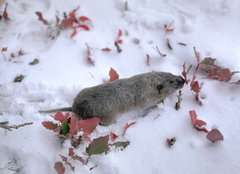Northern pocket gopher
| Northern pocket gopher | |
|---|---|
 | |
| Scientific classification | |
| Kingdom: | Animalia |
| Phylum: | Chordata |
| Class: | Mammalia |
| Order: | Rodentia |
| Family: | Geomyidae |
| Genus: | Thomomys |
| Species: | T. talpoides |
| Binomial name | |
| Thomomys talpoides Richardson, 1828 | |
| Subspecies | |
|
T. t. aequalidens | |
The northern pocket gopher (Thomomys talpoides) was first discovered by Lewis and Clark on April 9, 1805 at the mouth of the Knife River, North Dakota. These animals are often rich brown or yellowish brown, but also grayish or closely approaching local soil color and have white markings under chin. They also weigh less than a quarter of a pound (110 grams).
Their habitat consists usually of good soil in meadows or along streams; most often in mountains, but also in lowlands.
A special note about the northern pocket gopher is that it rarely appears above ground; when it does, it rarely ventures more than 2.5 feet from a burrow entrance. Underground, however, they often have tunnels that extend hundreds of feet where they live, store food and mate.
References
- ↑ Linzey, A.V. & NatureServe (Hammerson, G.) (2008). Thomomys talpoides. In: IUCN 2008. IUCN Red List of Threatened Species. Retrieved 15 March 2009. Database entry includes a brief justification of why this species is of least concern
| Wikispecies has information related to: Northern pocket gopher |
